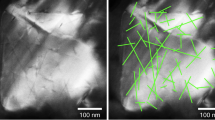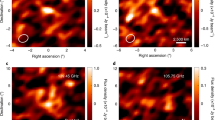Abstract
Streams of dust emerging from the direction of Jupiter were discovered in 1992 during the flyby of the Ulysses spacecraft1,2, but their precise origin within the jovian system remained unclear2. Further data3,4,5 collected by the Galileo spacecraft, which has been orbiting Jupiter since December 1995, identified the possible sources of dust as Jupiter's main ring6, its gossamer ring7, comet Shoemaker–Levy 9 (ref. 8) and Io. All but Jupiter's gossamer ring and Io have since been ruled out4,9,10,11,12,13,14. Here we find that the dominant source of the jovian dust streams is Io, on the basis of periodicities in the dust impact signal. Io's volcanoes, rather than impact ejecta, are the dust sources.
This is a preview of subscription content, access via your institution
Access options
Subscribe to this journal
Receive 51 print issues and online access
$199.00 per year
only $3.90 per issue
Buy this article
- Purchase on Springer Link
- Instant access to full article PDF
Prices may be subject to local taxes which are calculated during checkout


Similar content being viewed by others
References
Grün,E. et al. Ulysses dust measurements near Jupiter. Science 257, 1550–1552 ( 1993).
Grün,E. et al. Discovery of Jovian dust streams and interstellar grains by the Ulysses spacecraft. Nature 362, 428– 430 (1993).
Grün,E. et al. Dust measurements during the initial Galileo Jupiter approach and Io encounter. Science 274, 399– 401 (1996).
Grün,E. et al. Constraints from Galileo observations on the origin of Jovian dust streams. Nature 381, 395– 398 (1996).
Grün,E. et al. Galileo observes electromagnetically coupled dust in the Jovian magnetosphere. J. Geophys. Res. 103, No. E9, 20, 011-20, 022 (1998).
Showalter,M. R., Burns,J. A., Cuzzi,J. N. & Pollack,J. B. Jupiter's ring system—New results on structure and particle properties. Icarus 69, 458–498 ( 1987).
Showalter,M. R., Burns,J. A., Cuzzi,J. N. & Pollack,J. B. Discovery of Jupiter's ‘gossamer’ ring. Nature 316, 526–528 (1985).
Sekanina,A., Chodas,P. W. & Yeomans, D. K. Tidal disruption and the appearance of periodic comet Shoemaker–Levy 9. Astron. Astrophys. 289, 607–636 (1994).
Grün,E. et al. Dust streams from comet Shoemaker–Levy 9? Geophys. Res. Lett. 21, 1035–1038 (1994).
Hamilton,D. & Burns,J. A. Ejection of dust from Jupiter's gossamer ring. Nature 364, 695– 699 (1993).
Horányi,M., Morfill,G. & Grün, E. Mechanism for the acceleration and ejection of dust grains from Jupiter's magnetosphere. Nature 363, 144–146 (1993).
Horányi,M., Morfill,G. & Grün, E. The dusty ballerina skirt of Jupiter. J. Geophys. Res. 98, 21,245–21,251 (1993).
Horányi,M., Grün,E. & Heck,A. Modeling the Galileo dust measurements at Jupiter. Geophys. Res. Lett. 24, 2175–2178 (1997).
Maravilla,D., Flammer,K. R. & Mendis, D. A. On the injection of fine dust from the Jovian magnetosphere. Astrophys. J. 438, 968– 974 (1995).
Scargle,J. D. Studies in astronomical time series II: Statistical aspects of spectral analysis of unevenly spaced data. Astrophys. J. 263, 835–853 (1982).
McEwen,A. S. et al. Active volcanism on Io as seen by Galileo SSI. Icarus 135, 181–219 ( 1998).
Spencer,J. R. & Schneider,N. M. Io on the eve of the Galileo mission. Annu. Rev. Earth Planet. Sci. 24, 125–190 (1996).
McGrath,M. Io and the plasma torus. Science 278, 237 –238 (1997).
Johnson,T. V., Morfill,G. & Grün, E. Dust in Jupiter's magnetosphere—an Io source. Geophys. Res. Lett. 7, 305– 308 (1980).
Ip,W. H. The dust halo of Io. Geophys. Res. Lett. 24, 3671–3674 (1996).
Krüger,H., Krivov,A. V., Hamilton,D. P. & Grün,E. Discovery of a dust cloud around Ganymede. Nature 399 , 558–560 (1999).
Zook,H. A. et al. Solar wind magnetic field bending of Jovian dust trajectories. Science 274, 1501–1503 (1996).
Carr,T. D., Desch,M. D. & Alexander, J. K. in Physics of the Jovian Magnetosphere (ed. Dessler, A. J.) 248 (Cambridge Univ. Press, Cambridge, 1983).
Acknowledgements
We thank the Galileo project at JPL for effective and successful mission operations. We also thank J. A. Burns for helpful comments. This work was supported by Deutsches Zentrum für Luft-und Raumfahrt E.V. (DLR).
Author information
Authors and Affiliations
Corresponding author
Rights and permissions
About this article
Cite this article
Graps, A., Grün, E., Svedhem, H. et al. Io as a source of the jovian dust streams. Nature 405, 48–50 (2000). https://doi.org/10.1038/35011008
Received:
Accepted:
Issue Date:
DOI: https://doi.org/10.1038/35011008
This article is cited by
-
Review of research on lunar dust dynamics
Astrophysics and Space Science (2022)
-
The Dawn of Dust Astronomy
Space Science Reviews (2019)
-
Interplanetary Dust, Meteoroids, Meteors and Meteorites
Space Science Reviews (2019)
-
Dust in the Jupiter system outside the rings
Astrodynamics (2019)
-
Circumplanetary Dust Populations
Space Science Reviews (2019)
Comments
By submitting a comment you agree to abide by our Terms and Community Guidelines. If you find something abusive or that does not comply with our terms or guidelines please flag it as inappropriate.



